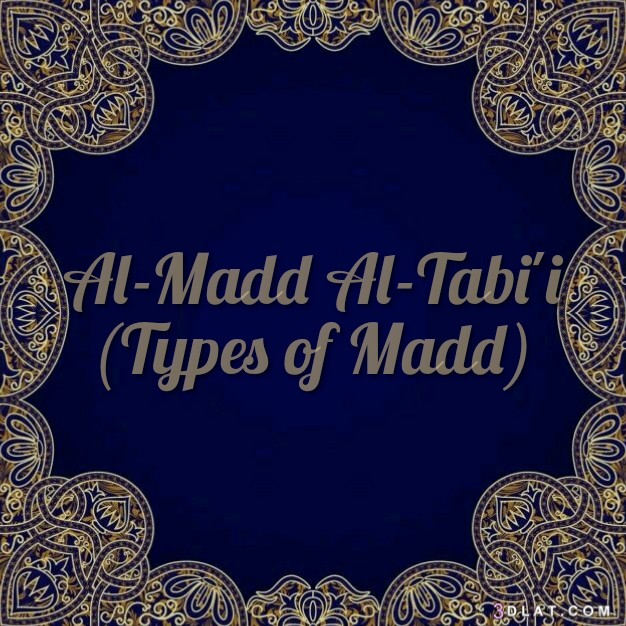Al-Madd is an important rule in Tajweed as it plays a very important role in understanding the meanings of the Quranic verses. There are only three letters related to al-Madd, but al-Madd has many types, lets talk about them in details.
Al-Madd, its definition and application:
Al-Madd is an Arabic word that means prolongation, and this means to extend the pronunciation of a letter, as the following examples: (السماء) it is an Arabic word means “the sky”, and (ا)Is the place of Madd. (غفور) it is an Arabic word means “Forgiving” and it is one of God’s Names, and (و)is the place of Madd. (رحيم) It is also one of God’s Names which means “Merciful”, and (ي)is the place of Madd. You can notice that al-Madd came with the letters (a, o, and e), and these are the corresponding letters for the Arabic letters (Alif, Waaw, and Yaa’), which are the three letters of Madd. The letters of Madd must be silent, without any vowel on them. but the letter which comes before the letter of Madd must not be a Hamza, and must have a vowel depends on the letter of Madd, as following; -If the letter of Madd is Alif, the letter before must have a fat-ha, and the Alif itself is silent with no vowel. -if the letter of Madd is Waaw, the letter before must have a dammah, and the Waaw is silent with no vowel. – if the letter of Madd is Yaa’, the letter before must have a kasra, and the Yaa’ itself is silent with no vowel. ** The letter before the letter of Madd Must has the mentioned vowels, otherwise Madd is not applied, and the letter is not named a letter of Madd. So if the letter of Madd is Waaw, and the letter before has a fat-ha instead of dammah, Madd will not applied, and Waaw is not a letter of Madd here. As in the word (يومكم) which means in English (your day), you can notice the letter (ي )has fat-ha, and the next letter (و)is not a letter of Madd , and no Madd is applied here, because (ي) has a fat-ha instead of dammah. ** The letter of Madd must be silent WITHOUT any vowel on it, and it does not mean that it has a sukoon, if the letter of Madd has a Sukoon, so, al-Madd is NOT applied, as in the following example; ( أولئك) And it means in English (They are), you can notice here that the letter ( أ )is an Alif with dammah, and is followed by the letter(و)Which has a sukoon, so Madd is not applied here, and it is not a letter of Madd, and is uttered أولئك notأوولئك. And in the same word the letter (ل)Has a fat-ha and is followed by (ا)Which has no vowel, so it is Alif of Madd and Madd is applied أولئك Where (ل )Is the place of Madd. Al-Madd is divided into two types; al-Madd al-Tabi’i or Asli, it means in English (normal or natural Madd), and al-Madd aL-far’i, and it means in English ( secondary Madd).Al-Madd al-Tabi’i:
It is applied on the letters of Madd (Alif, waaw, and Yaa’), they should be prolonged in pronunciation to two counts; it means that each letter of them is uttered in a time equal to the time of counting (one-two).Conditions of al-Madd al-Tabi’i:
The first condition of al-Madd al-Tabi’I is that the letter before the letter of Madd is not a hamza. The second condition that the letter of Madd is not followed by a hamza or a sukoon.Types of al-Madd al-Tabi’i:
If there is a dammah or Kasra on a pronoun or possessive pronoun,and the letter after it has a vowel, and the word is read continuously without stopping, as in (ما له * و ما كسب) as you can see (ه )is the pronoun with a damma vowel, and there is (ل )before it, which has a dammah vowel, and is followed by ( و )which has a fat-ha vowel, and (*) is the place of Madd. This type of Madd is called “the lesser Connecting Madd”. Another type of al-Madd al-Tabi’i is when a letter with Tanween with fat-ha, is the last letter in a ward which we will stop after. So this Tanween will be replaced by Alif Madd, as in, (ًهدا ) where ( ًد ا)has Tanween with fat-ha, at the end of the word, and we will stop after it, so it will be pronounced as Alif Madd as ( ًهد ا ) and this type is called “The substitute Madd”. And if hamza precedes any of the letters of Madd, this Madd is called “The exchange Madd” as in (آدم)this word originally is (أ أدم )where a hamza is followed by another hamza, so it is changed into a letter of Madd, according to thevowel of the first hamza to be (آدم)where (آ ) is Alif of Madd.This shortcode LP Profile only use on the page Profile



